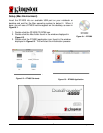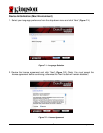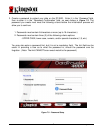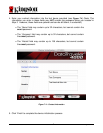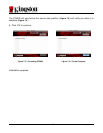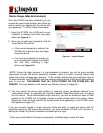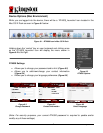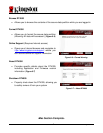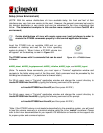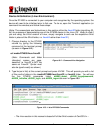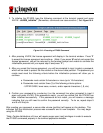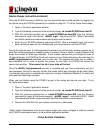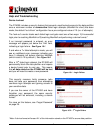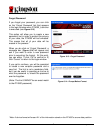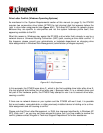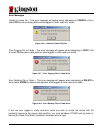
Document No. 48000127-001.A04 DataTraveler
®
4000 Page 20 of 27
Setup (Linux Environment)
(NOTE: With the various distributions of Linux available today, the ‘look and feel’ of their
interfaces may vary from one version to the next. However, the general command set used in
the terminal application is very similar and can be referenced in the Linux instructions that
follow. The screenshot examples in this section were created in a Linux CentOS v6.x
environment.)
Certain distributions of Linux will require super-user (root) privileges in order to
execute the DT4000 commands properly in the terminal application window.
Insert the DT4000 into an available USB port on your
notebook or desktop and wait for the Linux operating
system to detect it. When it does, a DT4000 volume icon
will appear* on the desktop, as seen in Figure 10.1.
The DT4000 comes with 5 commands that can be used
in Linux:
Figure 10.1 – DT4000 Volume
dt4000_about, dt4000_forgotpassword, dt4000_initialize, dt4000_login, and dt4000_logout
(Note: To execute these commands, you must open a “Terminal” application window and
navigate to the folder where each of the files exist. Each command must be preceded by the
following two characters: ‘./’ (a period and a forward slash.)
For 32-bit users, open a “Terminal” application window and change the current directory to
/media/DT4000/linux/linux32$ by typing the following command at the prompt:
cd /media/DT4000/linux/linux32 (and then press
ENTER.)
For 64-bit users, open a “Terminal” application window and change the current directory to
/media/DT4000/linux/linux64$ by typing the following command at the prompt:
cd /media/DT4000/linux/linux64 (and then press ENTER.)
*Note: If the DT4000 volume is not loaded automatically by the operating system, you will need
to load the volume manually in a terminal window using the Linux ‘mount’ command. Please
refer to the Linux documentation for your specific OS distribution or favorite on-line support site
for proper syntax and command options.



